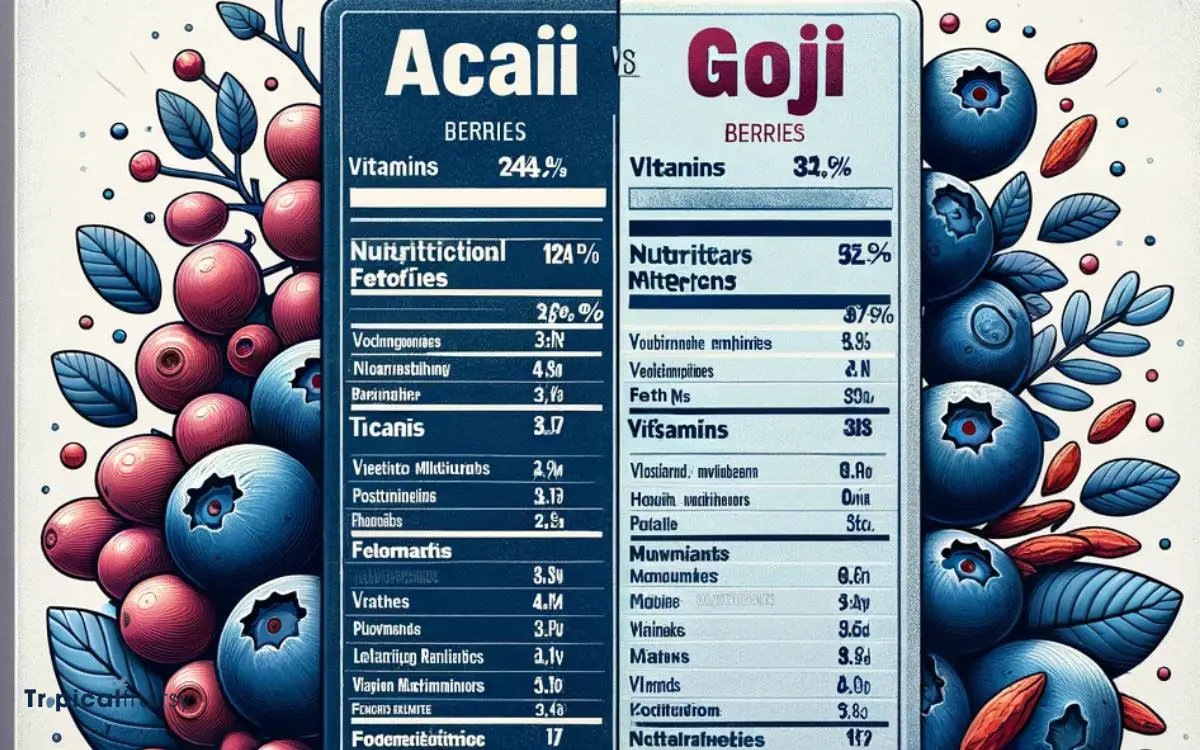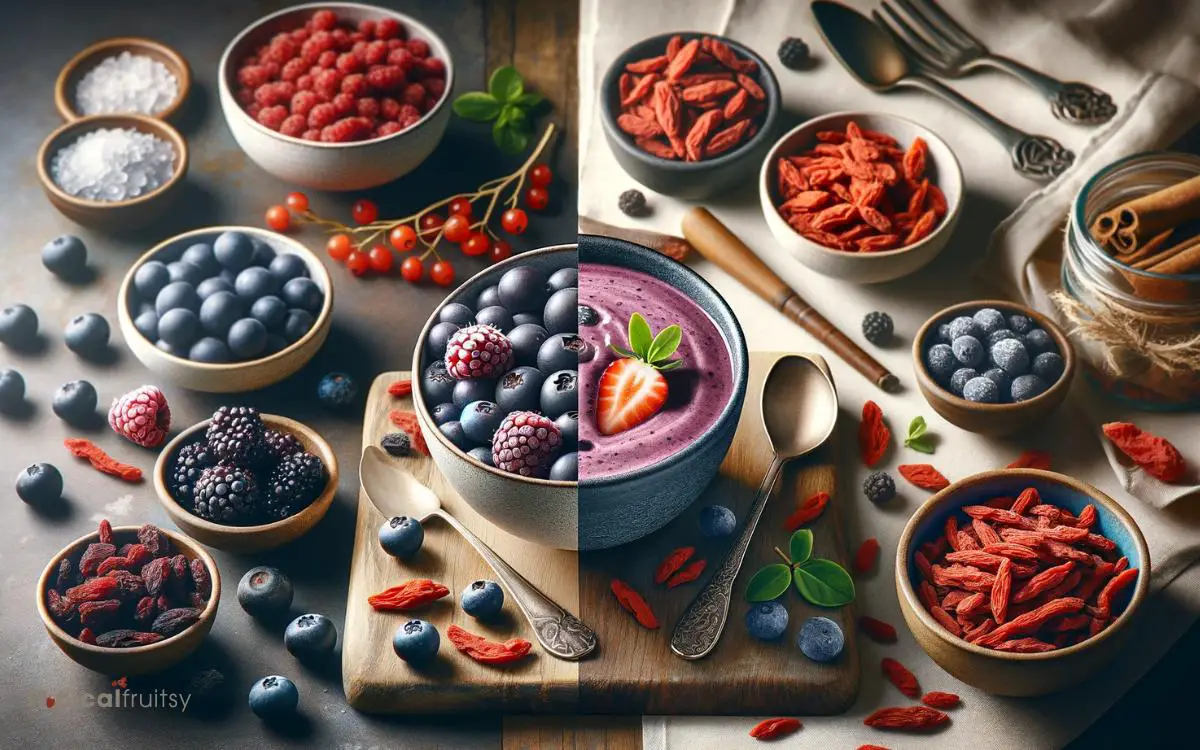Acai Berry Vs Goji Berry: Nutritional Comparison
Acai berries and goji berries are both celebrated for their health benefits and nutritional prowess. Acai berries are rich in antioxidants and may aid in heart health and weight loss, while goji berries are known for their high vitamin C content and potential to boost the immune system.
Acai berries come from the acai palm tree and are native to the rainforests of South America. They are dark purple and have a taste that’s often described as a blend of berries and chocolate.
Goji berries, also known as wolfberries, are typically found in Asia and have a sweet, slightly sour flavor. They are reddish-orange and have been used in traditional Chinese medicine for centuries.
Acai and goji berries both serve as nutrient-dense choices for those looking to enhance their diet with superfoods.

Key Takeaway
Acai Berry vs. Goji Berry: Nutritional Comparison and Benefits
| Nutrient | Acai Berry | Goji Berry |
|---|---|---|
| Origin | South America | Asia |
| Color | Dark Purple | Reddish-Orange |
| Taste | Berries and Chocolate | Sweet and Slightly Sour |
| Fiber | High | Moderate to High |
| Sugar | Low | Moderate |
| Healthy Fats | High | Low to Moderate |
| Protein | Low | Moderate |
| Vitamins | Vitamin A, E | Vitamin A, C |
| Antioxidants | Anthocyanins | Carotenoids |
| Health Benefits | Heart Health, Weight Loss | Immune Boost, Anti-Aging |
Nutritional Profile Comparison
When comparing the nutritional profiles of acai berries and goji berries, it is evident that both offer unique benefits, with acai berries being rich in antioxidants and healthy fats, while goji berries provide a diverse range of vitamins and minerals.
Acai berries contain anthocyanins, which contribute to their deep purple color and potent antioxidant properties. They also have a high content of monounsaturated fats, similar to those found in olive oil.

Goji berries, in contrast, are celebrated for their high vitamin C content, a crucial antioxidant, and are also a good source of vitamin A, iron, and fiber.
Both berries have been credited with a myriad of health benefits, attributed to their rich and distinct nutrient compositions.
This sets the stage for a deeper dive into the antioxidant capacity showdown of these two superfruits.
Antioxidant Capacity Showdown
Delving into the antioxidant capacity of these superfruits, acai berries boast a higher concentration of anthocyanins compared to goji berries, which may provide superior scavenging activity against free radicals.

The measure of this capacity can be assessed through various assays, such as ORAC (Oxygen Radical Absorbance Capacity).
Antioxidant Capacity:
Acai Berries:
- High levels of anthocyanins and flavonoids
- Potent ORAC values, suggesting robust free radical neutralization
Goji Berries:
- Rich in carotenoids like zeaxanthin
- Exhibit strong antioxidant properties, but generally lower ORAC scores than acai
Comparative Studies:
- Suggest acai may offer more potent antioxidant defenses
- Acknowledge both berries contribute significantly to dietary antioxidant intake
Evidence-based research indicates that both berries are healthful, yet acai may edge out goji in pure antioxidant potential.
Taste and Texture Examination
When assessing acai and goji berries, the sensory aspects play a crucial role in consumer preference.
The flavor profile of acai berries is often described as a blend of rich berries with a hint of chocolate, while goji berries are noted for their slightly sweet, tangy taste with an herbal afternote.

Furthermore, the texture is a distinguishing factor, with acai berries presenting a softer, pulpy consistency and goji berries offering a distinct chewiness that persists even when dried.
Flavor Profile Differences
Both acai berries and goji berries offer distinct flavor profiles. Acai berries typically present a rich, tart taste and a creamy texture.
On the other hand, goji berries are known for their sweet and slightly sour undertones with a chewy, often dried consistency.
Acai Berries:
- Taste: Earthy and rich with a hint of bitterness similar to dark chocolate.
- Texture: Creamy and smooth when pureed; similar to a thick smoothie when consumed as a bowl.
- Usage: Often blended in beverages or bowls, which may alter the natural taste with added ingredients.
Goji Berries:
- Taste: Naturally sweet with a tangy, herbal afternote.
- Texture: Chewy and tender, particularly when dried, akin to raisins.
- Usage: Commonly eaten dried, added to teas, or rehydrated in cooking.
Understanding these nuanced differences assists consumers in making informed decisions about incorporating these superfoods into their diets.
Berry Chewiness Comparison
In terms of chewiness, goji berries exhibit a significantly higher degree of this quality compared to the softer, pureed texture of acai berries when prepared for consumption.
Dried goji berries, which are the form most commonly available, possess a chewy, almost raisin-like texture that requires a bit of effort to bite through. This characteristic is due to the dehydration process, which concentrates their fibrous content.
On the other hand, acai berries are typically consumed as a pulp or in a blended form, contributing to their much smoother and creamier texture that is often incorporated into bowls and smoothies.
This distinct textural difference is a result of the berries’ intrinsic properties and their traditional preparations.
With the chewiness aspect addressed, let’s delve deeper into the texture nuances explored in the following section.
Texture Nuances Explored
The complexity of a berry’s texture can significantly influence its culinary applications and sensory appeal.
When examining the texture nuances of acai and goji berries, one finds:
Acai Berry:
- Soft and pulpy
- Blends smoothly in beverages
- Velvety consistency when pureed
Goji Berry:
- Chewier and drier in natural form
- Often consumed as dried fruit with a raisin-like texture
- When rehydrated, plumps up but retains a tender bite
This detailed exploration reveals that acai berries provide a creamier experience suitable for smooth concoctions, while goji berries offer a satisfying chew, excellent for textural contrast in dishes.
Understanding these textures aids in optimizing their use in various recipes, ensuring a harmonious balance between taste and mouthfeel.
Transitioning from texture to health implications, the subsequent section delves into the ‘health benefits evaluation’ of these nutrient-dense superfruits.
Health Benefits Evaluation
Comparing the health benefits of acai berries to those of goji berries reveals a rich tapestry of nutrients and bioactive compounds beneficial for various aspects of human health.

Both berries are celebrated for their high antioxidant content, which can help combat oxidative stress and may reduce the risk of chronic diseases.
| Nutrient/Benefit | Acai Berry | Goji Berry |
|---|---|---|
| Antioxidants | High in anthocyanins | Rich in carotenoids |
| Vitamins | Good source of vitamin A | High in vitamins A, C, and B2 |
| Anti-inflammatory | Contains anti-inflammatory agents | Polysaccharides with immune support |
| Heart Health | May improve cholesterol levels | May help regulate blood sugar |
Evidence suggests that both acai and goji berries have distinctive profiles that support cardiovascular health, immune function, and may have anti-aging effects.
Now, let’s transition to their culinary uses and recipes to understand how these nutritional powerhouses can be incorporated into daily diets.
Culinary Uses and Recipes
Acai berries and goji berries not only offer impressive health benefits but also add vibrant flavor and color to a variety of culinary creations.

These superfruits can be incorporated into dishes in multiple ways:
Acai Berries:
- Smoothie Bowls: Blended with bananas and other fruits, topped with granola and coconut flakes.
- Juices: Pureed and strained for a nutritious drink, often mixed with other berry juices.
- Desserts: Sorbets and acai berry cheesecakes with a rich, purple hue.
Goji Berries:
- Teas: Steeped in hot water, sometimes with green tea or herbs.
- Baked Goods: Sprinkled into muffins, cookies, and energy bars.
- Salads: Added to greens for a sweet and chewy contrast.
Using these superfruits, cooks can craft dishes that are as beneficial to health as they are delightful to the palate.
Which Berry Has Better Nutritional Benefits, Acai Berry or Goji Berry?
When comparing the nutritional benefits of acai berry and goji berry, it’s important to consider the specific benefits of each. Both berries are rich in antioxidants, vitamins, and minerals, making them popular choices for health-conscious individuals. When shopping for top acai berry supplements, be sure to look for reputable brands with high-quality ingredients.
Accessibility and Price Points
When considering the purchase of acai and goji berries, one must take into account their varying levels of accessibility and differing price points.
Acai berries typically hail from the Amazon region and are often found in frozen or powdered form outside their native area. This can affect their availability and result in a higher price, particularly for organic varieties.

Goji berries, originating from China, are more widely cultivated globally and are commonly available dried, which may ease distribution and reduce costs.
Prices for both berries are influenced by factors such as seasonality, demand, and organic certification.
Consumers should expect to pay a premium for these nutrient-dense superfoods, with acai generally being the more expensive option due to import and preservation considerations.
Conclusion
Both acai and goji berries exhibit unique nutritional profiles, with notable antioxidant properties. While acai berries offer a rich, creamy texture, goji berries provide a chewy experience with a slightly sweet taste.
Each berry contributes distinct health benefits, which have been substantiated through scientific research.
Culinary versatility and global accessibility, although variable, enhance their appeal.
Despite differing price points, the incorporation of either berry into a balanced diet can contribute to overall health and wellness.






